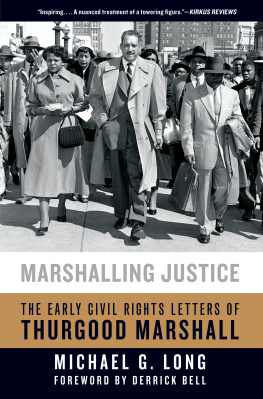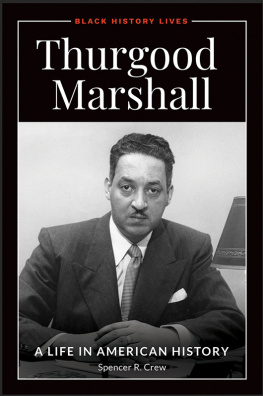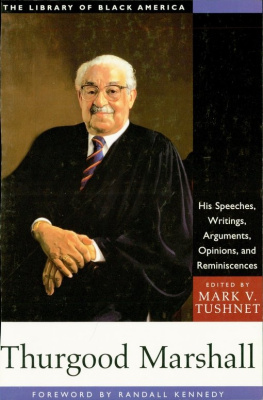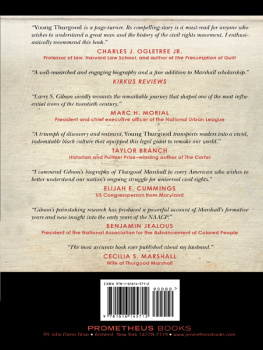ROOT AND BRANCH
ROOT AND BRANCH
Charles Hamilton Houston, Thurgood Marshall,and the Struggle to End Segregation
RAWN JAMES, JR.

For my parents, Rawn Sr. and Sara James
Copyright 2010 by Rawn James, Jr.
All rights reserved. No part of this book may be used or reproduced in any manner whatsoever without written permission from the publisher except in the case of brief quotations embodied in critical articles or reviews. For information address Bloomsbury Press, 175 Fifth Avenue, New York, NY 10010.
Published by Bloomsbury Press, New York
LIBRARY OF CONGRESS CATALOGING-IN-PUBLICATION DATA
James, Rawn.
Root and branch : Charles Hamilton Houston, Thurgood Marshall, and the struggle to end segregation / Rawn James, Jr.1st ed.
p. cm.
Includes bibliographical references.
ISBN 978-1-59691-606-7 (hardcover)
1. Marshall, Thurgood, 19081993. 2. Houston, Charles Hamilton, 18951950. 3. African American judgesUnited StatesBiography. 4. African American law teachersUnited StatesBiography. 5. SegregationUnited StatesHistory. 6. Race discriminationUnited StatesHistory. I. Title.
KF372.J36 2010
347.73'140922dc22
[B]
2009026497
First published by Bloomsbury Press in 2010
This e-book edition published in 2010
E-book ISBN: 978-1-60819-168-0
www.bloomsburypress.com
CONTENTS
T HE FOXHUNTING SET OF Loudoun County, Virginia, had been on edge for weeks even before the two women were found murdered. With alarming ease, burglars had been stealing china, jewels and even furniture from the Georgian homes scattered atop the rolling hills that lay about forty miles northwest of Washington, D.C. No suspects had been taken into custody, and homeowners in towns like Leesburg were oiling their rifles for more than mere sport during the first weeks of 1932.
On one mild January night, furniture designer Paul Boeing retired to the big house of his familys estate, where he slept warily prepared to defend the property against any would-be intruders. Boeing awoke the next morning after an uneventful sleep, donned an overcoat atop his pajamas, slid on an old pair of shoes and welcomed the crisp morning with a stroll across the lawn to the cottage where his sister and her maid had spent the night.
His knocking went unanswered. Boeing opened the door, stepped into the cottage and jumped back outside as if thrown by a man twice his size. His sister, Agnes Boeing Ilsley, lay beaten to death on the cottage floor; Mina Buckner, Agness maid, lay dead in the next room with her skull crushed and one hand stiffly clutching her set of false teeth. Investigators later found the scratched bits of a black persons hair and skin caked in blood beneath Agness fingernails.
Before the sun struck noon that day, a band of white men had swarmed through several towns in Loudoun County searching for the man they were convinced had murdered the socially prominent Mrs. Ilsley and her maid. Despite the fact that several of the men were well-to-do members of the countys gentry, their group comprised a lynch mob. They planned to find the murderer, torture him, castrate him and kill him.
But by nightfall it had become clear to them that they were not going to find the killer. It would be more than a year before they learned that the man they sought, George Crawford, was arrested in Boston. It would be another year before the Loudoun County courthouse resonated for the first time with the voice of an African American lawyer rising in defense of Crawford, by then formally accused of murdering the two women. And it would be a few months after that when a writer for the WashingtonPost declared, If there ever was a lucky Negro, he is George Crawford.
IN 1932, the chief executive of the National Association for the Advancement of Colored People had straight blond hair and blue eyes, a thick mustache and a thin mans tendency to disappear inside double-breasted suits. By all accounts Walter White looked Caucasian. My skin is white, he wrote on the first page of his autobiography, my eyes are blue, my hair is blond. The traits of my race are nowhere visible upon me. Gunshots scattered the horde, and the shaken blond boy decided that he forever would be black.
Ten years later White joined the NAACP after graduating from the Atlanta University. Field Secretary James Weldon Johnson, impressed with Whites volunteer efforts in the Atlanta branch, hired him as an assistant field secretary. The young staffers transracial appearance quickly proved an invaluable asset: From 1918 to 1929, White repeatedly went undercover to mingle with Klansmen and murderers and bloodthirsty lots. Posing as a white man, he investigated forty-one lynchings and eight race riots. He publicized their stories and plans through the NAACP. For life White was haunted by what he saw and heard during those eleven years.
The fight against lynching became Walter Whites crusade. He wrote several critically acclaimed books on the subject, and, after working his way up to become the NAACPs chief executive, he vowed to use every means at his disposal to stop the brutal killings. In his New York City office in January 1933, White read in the newspapers that a black man was arrested in Boston and had confessed to murdering two white women in rural Virginia the year before. Eight days after confessing, however, the suspect claimed that he had not killed the women and in fact had been in Boston when the crime occurred. Several witnesses substantiated his alibi. Nonetheless, authorities in Massachusetts began making arrangements to extradite the suspect, George Crawford, to Virginia.
The entire affair looked to Walter White like a legally sanctioned lynching. While it could not patrol the swamps and thickets where white mobs slaughtered black men, the NAACP could stand guard against Americas courtrooms becoming the sites of slaughter. George Crawfords life could be saved if the association could keep him from being extradited to Virginia.
LOUDOUN COUNTY PROSECUTOR John Galleher had rushed to Massachusetts upon word of Crawfords arrest, pausing only for his own wedding in Washington. The morning after the wedding night, Galleher left for Boston with his bride in tow, on what the Associated Press called an extradition honeymoon.
After his arrest, Crawfords NAACP lawyers, led by Bostonian Butler Wilson, fought extradition on the grounds that black citizens were excluded from Virginias juries in violation of the Fourteenth Amendments guarantee of equal protection of the laws. The lawyers persuaded federal judge James A. Lowell and he ordered Crawford released. Why send this man back to Virginia when I know and everyone knows the Supreme Court will say his trial is illegal? the judge demanded. The lawyers are the only ones who will get anything out of it. The whole thing is absolutely wrong.
Virginia appealed, with its attorney general exclaiming, Why, under [Lowells] ruling, it would be illegal to try any colored person before a Virginia jury for any offense! Likewise infuriated by his professed reliance on Yankee common sense, Congress impeached Judge Lowell, who suddenly fell sick. Ten days later the sixty-four-year-old judge died in Newton, Massachusetts.
The circuit court of appeals overturned Lowells ruling. It held that because Virginia did not by statute exclude African Americans from jury service, its juries were constitutionally sound; whether or not black people ever actually served on Virginias juries was irrelevant. Crawfords attorneys appealed to the Supreme Court, but the justices declined to hear the case. The thirty-two-year-old black man was returned to Loudoun County to stand trial for capital murder.
Next page







